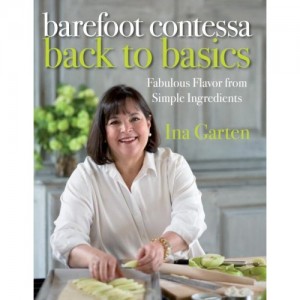Unless you’re already wealthy, I doubt you’re able to just jaunt off to Paris for a couple years at Le Cordon Bleu (which is what I should have done instead of going to Oxford; ah, the joys of jaded youth). A lot of us are forced to learn to cook through imitation — ie, via a cookbook. That’s how I’m learning, and until Matt becomes a zillionaire, that’s how I’ll roll.
2008 saw the release of the Barefoot Contessa’s newest cookbook, Barefoot Contessa: Back to Basics, which was a tie-in to the rebooting of her eponymous cooking show on the Food Network. Anyone familiar with Ina Garten (and if you aren’t, I may come to your home and smack you around a bit) is aware that she stands for simple, elegant entertaining with exquisite ingredients and good friends. Since 1999, she’s been something of a cookbook mogul, with her first cookbook, The Barefoot Contessa Cookbook, and later Barefoot in Paris, selling almost ridiculously well. And that’s because her food is damned good.

Unfortunately, the first cookbooks aren’t for the faint of heart or faint of budget. Barefoot in Paris, the first cookbook I received by Garten, does exactly what it says it will: help bring “the romance and enduring appeal of French country cooking” into your home. That’s a very provocative offer, Ina, but a novice cook will easily be intimidated by recipes for a blue cheese souffle (I can hear them screaming “I’m not ready yet!” — much as I did), balk at unknown words like “celery root remoulade,” or simply be unable to create the showstoppers like coeur a la creme, which for obvious reasons requires a special heart-shaped ceramic mold.
The big food boom for home cooks in the 2000s made the words “quick, easy, tasty” its credo. That’s the reason Rachael Ray became a superstar; her 30 Minute Meals gave the homecook some new kitchen ideas with minimal time and effort. I applaud Rachael for making cooking mainstream. Are her recipes great? No. They are quick, but require no technique, no chefly finesse, and as such they must rely on a plethora of crazy-fresh ingredients, which for one meal turns out to be damn costly, especially when one considers the quality of the end result and the lack of skill retention.
That’s where Garten’s Back to Basics comes in. At first, I was apprehensive of this title; I felt betrayed. I had worked my way through that damned (and I say this lovingly) Barefoot in Paris and I’ll be double damned if I don’t get to chiffonade anything or have to omit pretentious cooking words like “coulis” (which really is just a fancy word for “sauce,” shh) from my food. Still, it was Ina and I’d sooner go straight than miss out on one of her cookbooks (plus, Mattie got it signed for me).
The whole key to Back to Basics isn’t to teach a novice how to make a plain ol’ roast chicken and mashed potatoes; rather, it’s about taking classic recipes, teaching the basic technique behind them, and then manipulating the flavors so that they taste even “more” like the ingredients than before. Chocolate is more chocolately (key: coffee); tomatoes more tomatoey (roast them, baby). Mastering these secrets gives you enough culinary experience points to be a hero.
Like all of Ina’s recipes, though, these rely on good quality ingredients. On her show, she’s been known to say “use whatever you have,” but that’s if we’re talking about a white onion versus a yellow onion. She’s got some real zingers in here that make a few recipes cost-prohibitive, like her filet of beef sandwich that calls for black truffle butter or her chicken bouillabaise that needs saffron. I know I launched a similar complaint against Rachael Ray, but investing in the ingredients in Ina’s case lets you turn out some high-quality dishes for minimal effort. After all, I’m more willing to splurge on Roquefort if I know that the technique is sound and easy to execute; wasting Roquefort on a failed souffle, on the other hand, is the culinary equivalent of an ass-raping without lube.
Back to Basics succeeds in giving the novice cook plenty of impressive recipes well within their skill level, and imparts some pretty nifty tricks and tips that will no doubt impress your friends if you ever watch the Food Network together (a favorite snobby-hobby of mine). If you’re looking for some high quality cookery and are a little shy about your kitchen prowess, skip Rachael Ray and start right here — you’ll feel like you’ve gotten first place after running a 20-mile marathon. Barefoot.
Brian’s Fav Recipes from the Book:
-Roasted shrimp cocktail
-Pomegranate cosmopolitans
-Herb-marinated loin of pork
-Fruit salad with limoncello

The herb-marinated loin of pork is amazing every time.
The Ask Ina section as well as the scattered pages of party tips I found to be exceptionally helpful, too. Things like “Ten No-Cook appetizers” or an explanation of the best ingredients is always helpful.
I think Matt will become a zillionaire soon; worry not!
Wow,so niceeee!! Thanks for sharing!